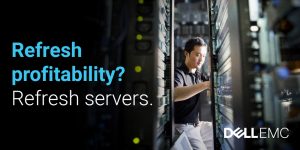More and more, as the world’s digital transformation accelerates, technology isn’t just a business enabler, it is the business. Take FedEx, for example. Pioneering founder and CEO Frederick W. Smith was among the first to recognize that technology defined his business model when he described FedEx as “an IT company that ships boxes to pay for all its infrastructure.”
To be sure, FedEx didn’t sit still, nor did competitors like UPS, DHL or even the U.S. Postal Service, but kept investing in its infrastructure for speed and agility. Today all of these companies continue to invest in keeping their server infrastructures fresh because they know it pays dividends to do so. They do it not only to boost company speed and lower costs, but also to enable new applications and services that might not otherwise be possible. Plus, they gain increased agility necessary to respond to new opportunities.
IDC Makes the Business Case for Refreshing Servers Every Three Years

According to market research firm IDC, the operating costs of a data center’s servers rise dramatically after their third birthday. In fact, in years 4–6, the cumulative operating costs of older servers can be 10x more than an old server’s initial expense. Not only is that more than enough to pay for new servers, but the latest server technology can also provide far more performance, scalability and agility to manage workloads.
In a study based on interviews with 14 companies averaging $8 billion in annual revenues, IDC made several findings that support a compelling business case for refreshing servers more frequently. One was that companies could save $14.6 million with two refresh cycles — each three years long — over a six-year span, which has been the traditional refresh cycle. Another was that the added speed, scalability and agility can help these firms generate an average of $4.7 million in extra revenue. Finally, IDC found that more savings and revenues meant the ROI on the cost of new servers was less than a year.
Dell EMC Responds to Customers’ Needs With 14th-Generation Servers
In July, Dell EMC announced the availability of its latest PowerEdge servers, the 14th generation. Our newest lineup of five new PowerEdge server models incorporate several years and hundreds of millions of dollars in R&D investment to meet the kinds of IT transformation needs that IDC noted in the study just mentioned.
So what’s new? While their innovations are many, they fall into three key categories:
- Optimized, scalable business architecture. In the past, servers were designed to handle multiple workloads, treating those equally, even if each one was vastly different. Server model choices involved processor speed, memory and density.
Today’s 14th-generaton PowerEdge servers provide all that using the most advanced technologies available, but each model’s architecture and engineering are optimized for specific categories of workloads, especially in terms of workload acceleration, storage and tuning. Examples include mission-critical databases; virtual desktop infrastructure (VDI) and machine learning; big data and software-defined storage; and high-performance computing and high-frequency trading.
For example, compared to PowerEdge R720 servers that used traditional, shared HDD storage, the new PowerEdge R740xd servers sport new, low-latency Non-Volatile Memory Express (NVMe) technology in a VMware vSAN environment. This optimization can enable them to process up to eight times more database operations per minute.
- Intelligent Automation. The new PowerEdge servers can help companies further transform their IT efficiency by automating the entire server lifecycle from deployment to retirement with embedded intelligence that dramatically increases IT staff productivity. With expanded APIs and an all-new OpenManage Enterprise console, IT team members can spend more time on higher-priority work.
What’s more, the enhanced iDRAC 9 delivers up to four times better systems management performance over the prior generation of PowerEdge servers. Joe Wiese, a systems design engineer at Rackspace Hosting, says:
“I totally love the new iDRAC 9. The new version is quite comprehensive and can be used to configure most everything for managing and maintaining the servers…the iDRAC, the PERC, the NICs and the BIOS all through a single web interface. It is hands-down the single greatest addition to PowerEdge that I have encountered.”
- Integrated Security. With cyber threats growing in frequency and sophistication, the newest PowerEdge servers offer a deep layer of defense built into their hardware and firmware. They also feature quick detection to enable, if breached, a fast recovery to a trusted base.
Among other security features is System Lockdown, an industry-first. It prevents configuration changes that can create security vulnerabilities and expose sensitive data. In addition, features such as Secure Boot, BIOS Recovery capabilities, signed firmware and iDRAC RESTful API (compliant with Redfish standards) provide enhanced protection against attacks.
Where Do You Stand? Assess Your Infrastructure and Learn More
For those of you interested in assessing the performance of your servers and workloads, Dell EMC offers its Performance Analysis Collection Kit, also known as DPACK.
Based on an industry-standard method of impartially documenting the performance of one server or a group of them, DPACK is a cloud-based, IT infrastructure–planning software tool that you can download from Dell for free. This analysis service is hardware- and platform-agnostic. It records workload characteristics, measures performance and creates simulations from various industry-leading server platforms.
And if you haven’t had the chance to read it yet, we invite you to download the free, 20-page IDC white paper, “Accelerate Business Agility with Faster Server Refresh Cycles.”
Finally, for more insights into the new Dell EMC 14th-generation, workload-optimized PowerEdge servers, check out this recent blog post from Brian Payne, Dell EMC Executive Director of Product Management.